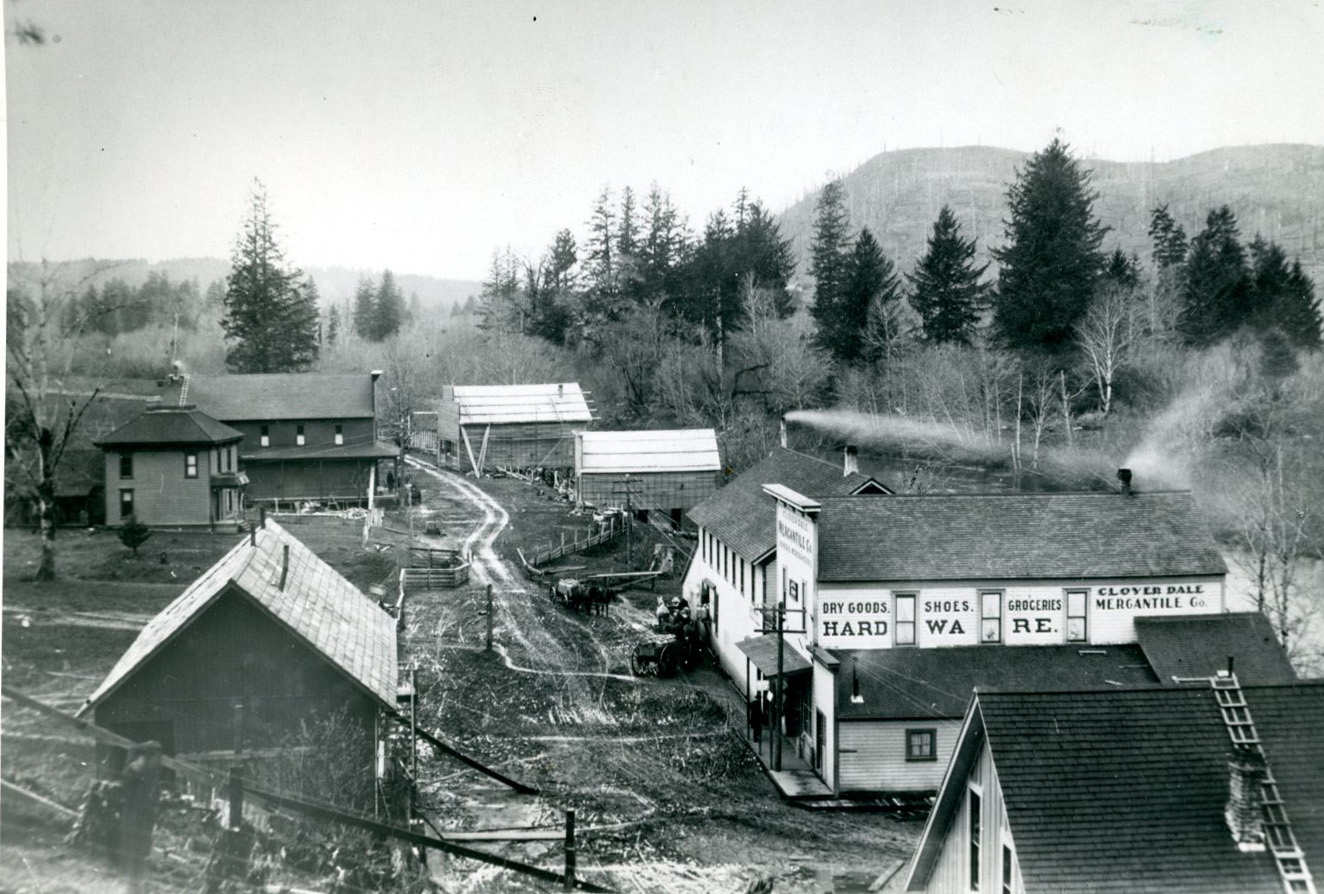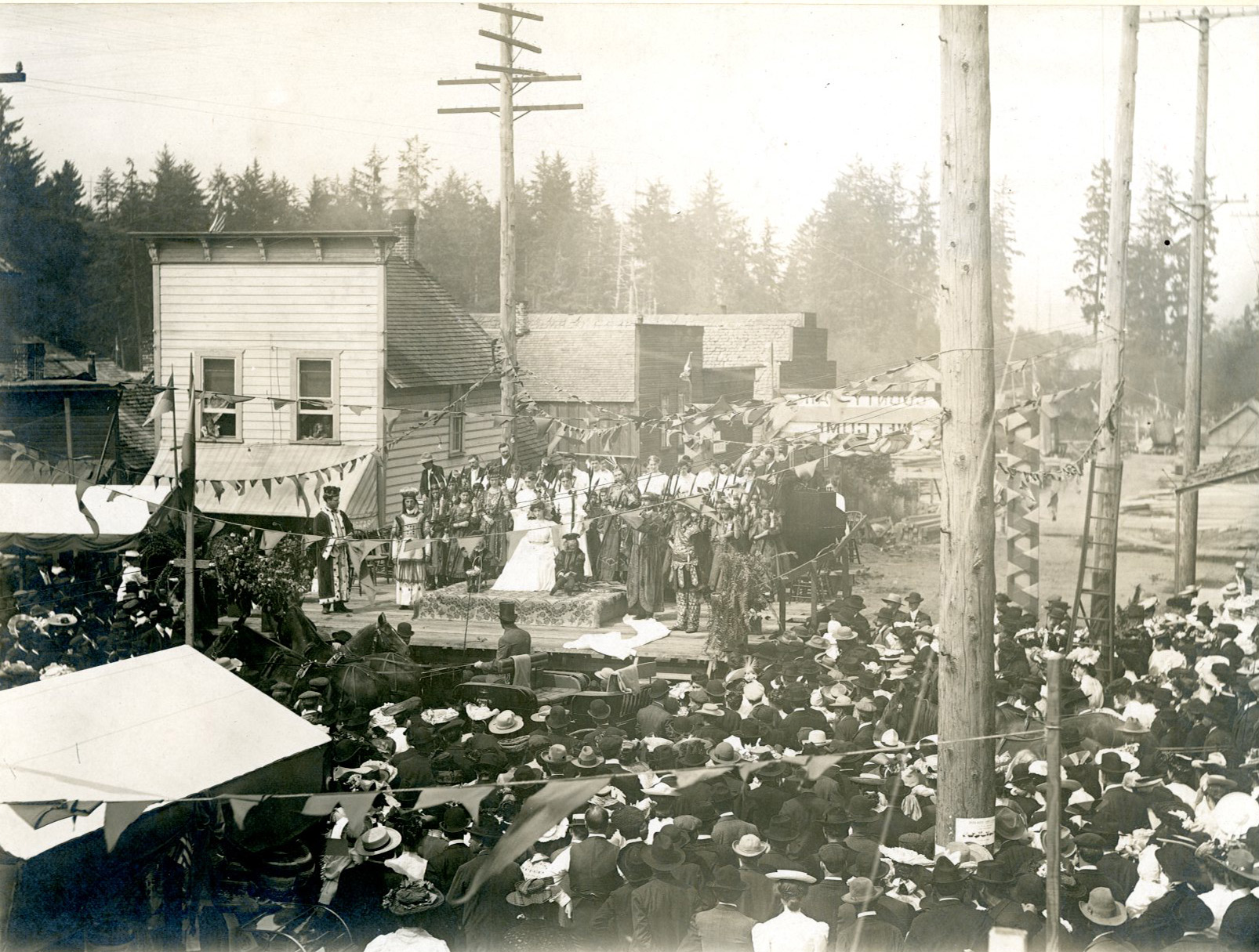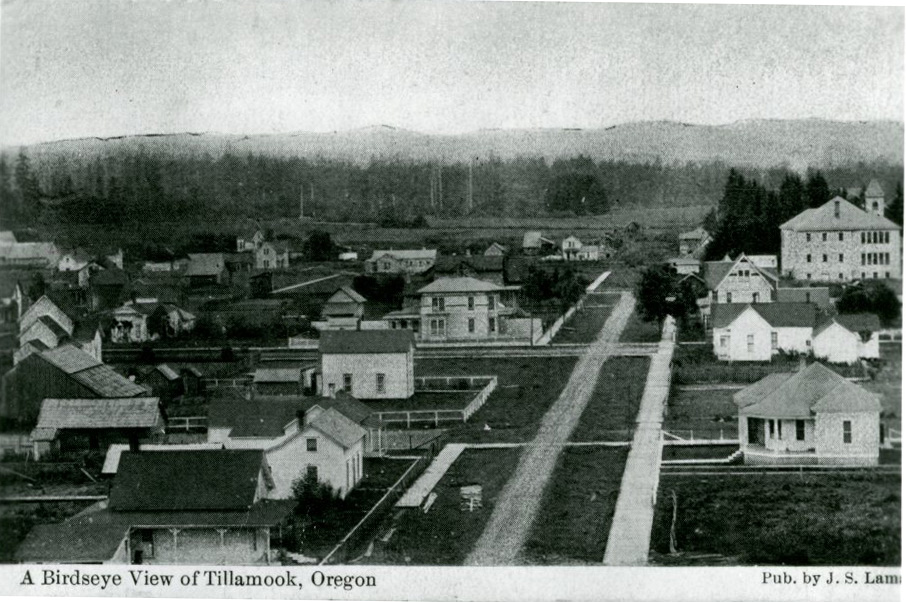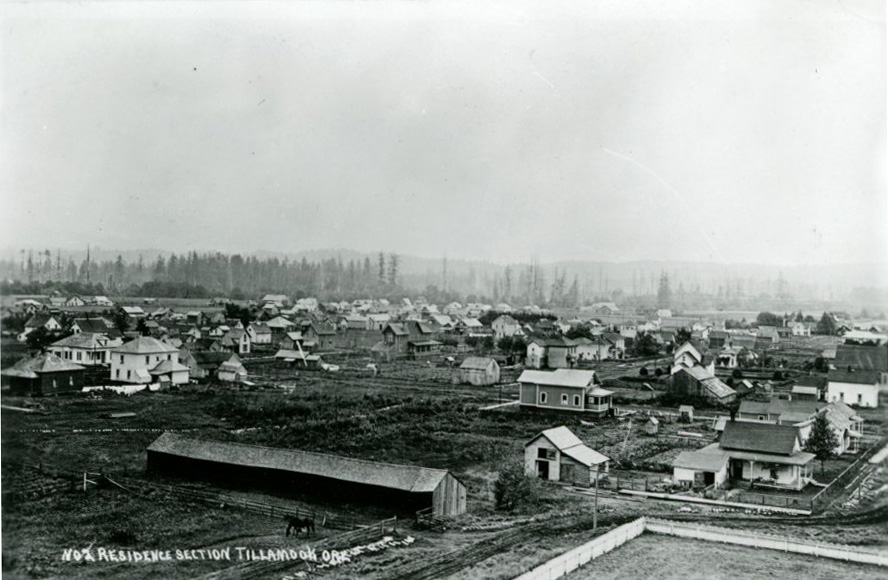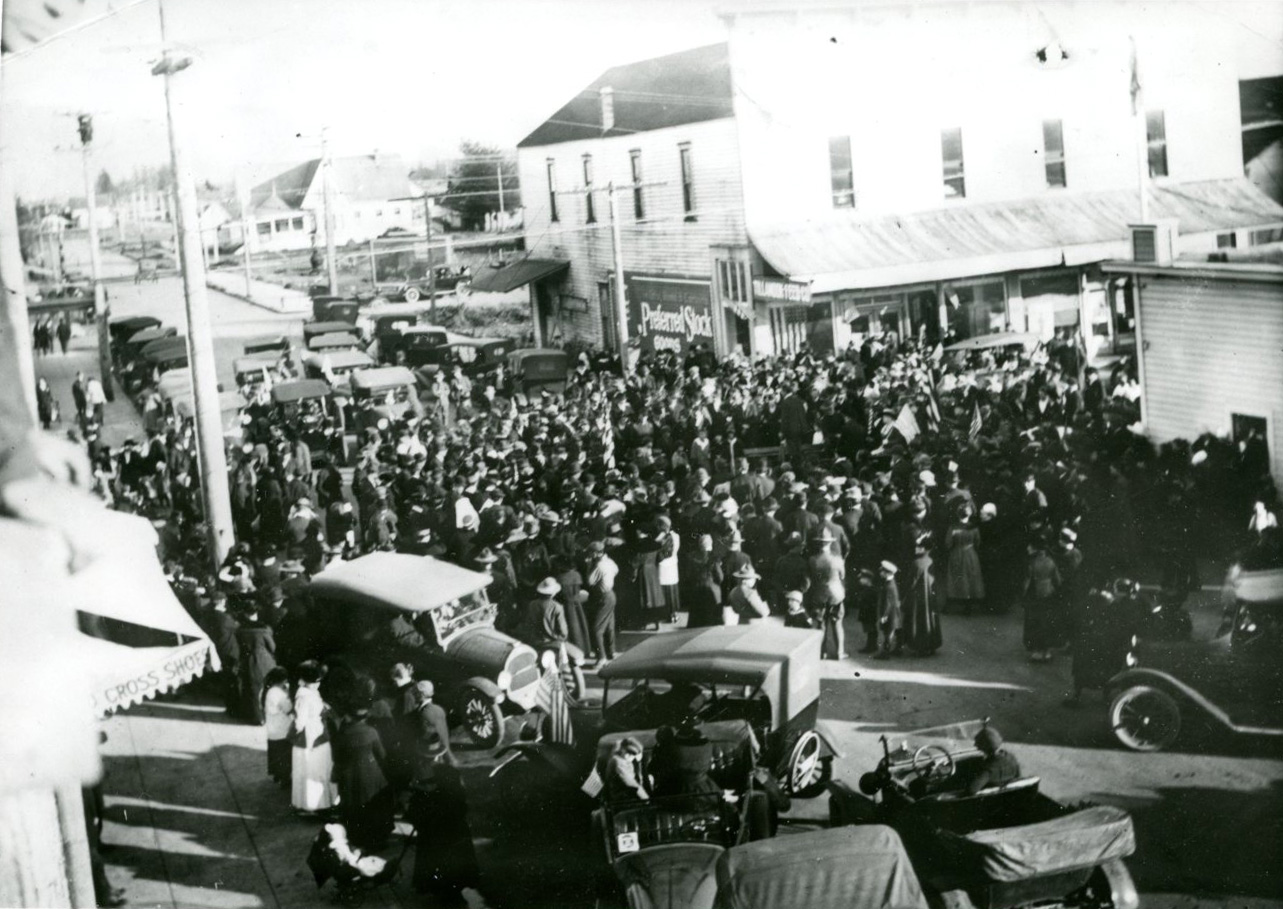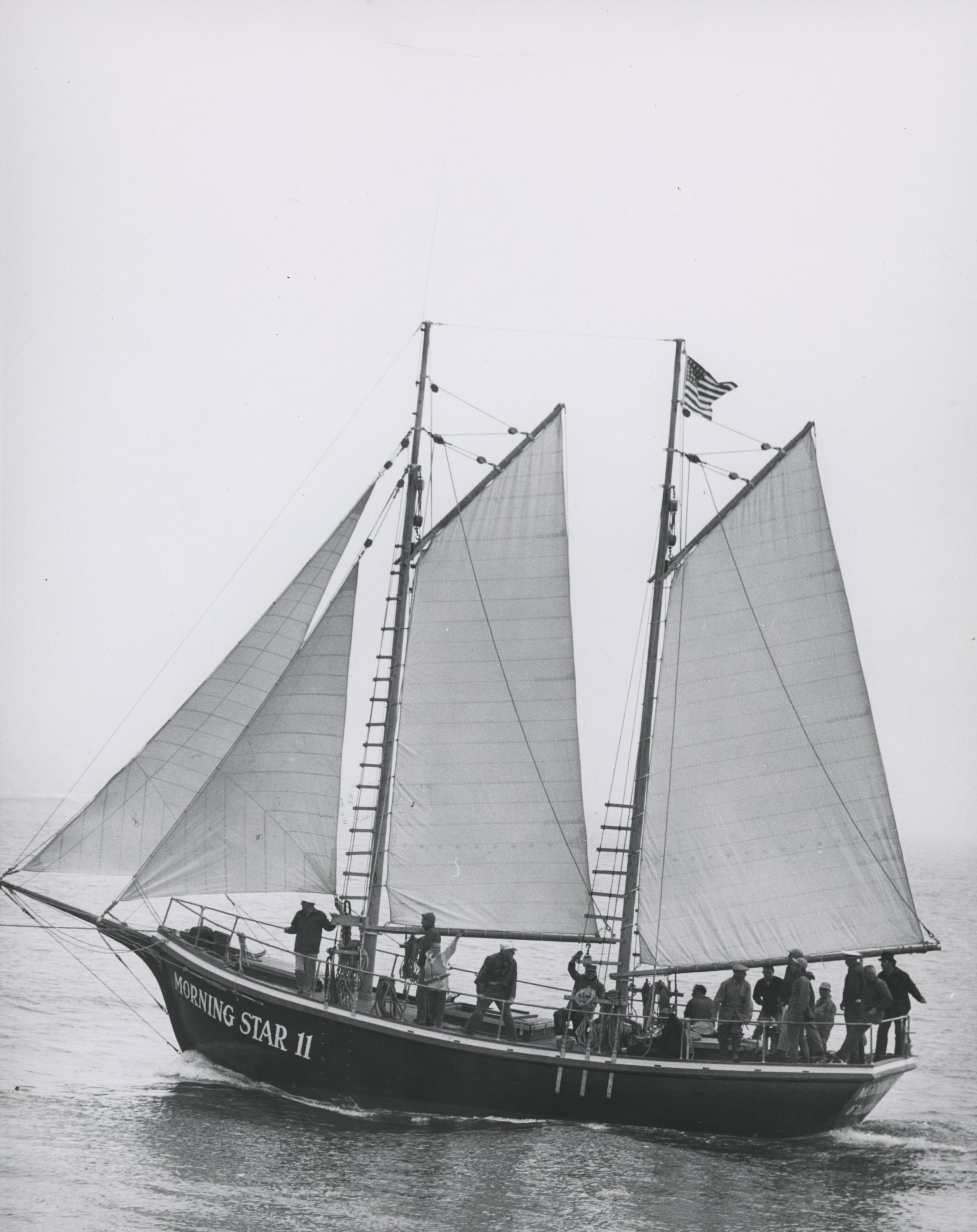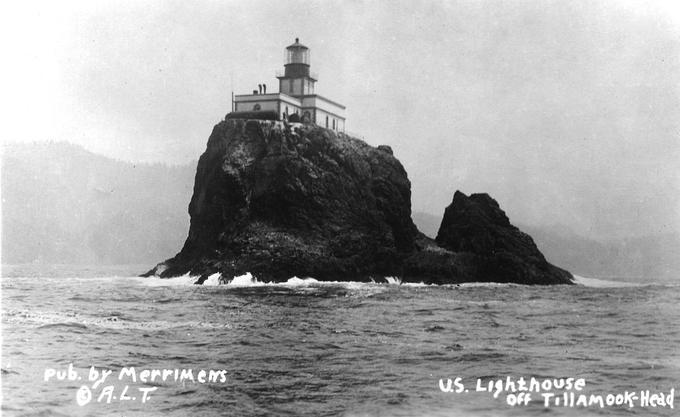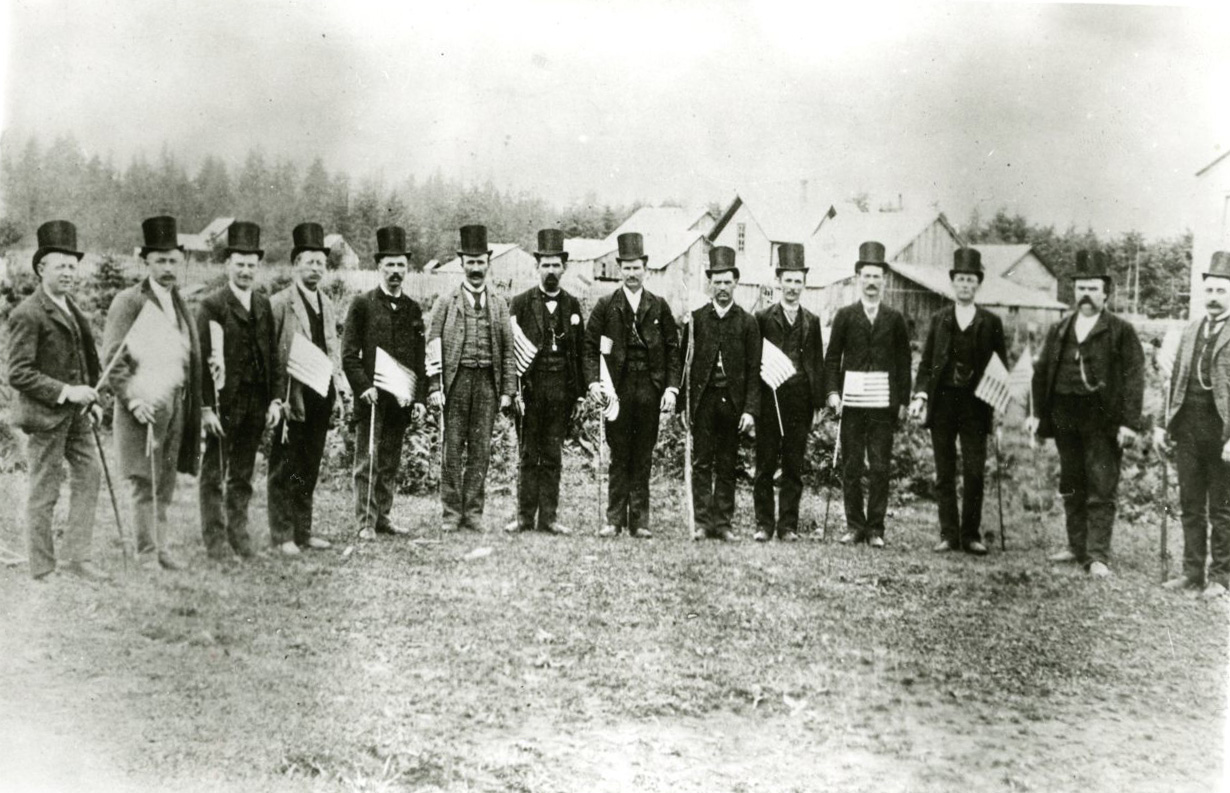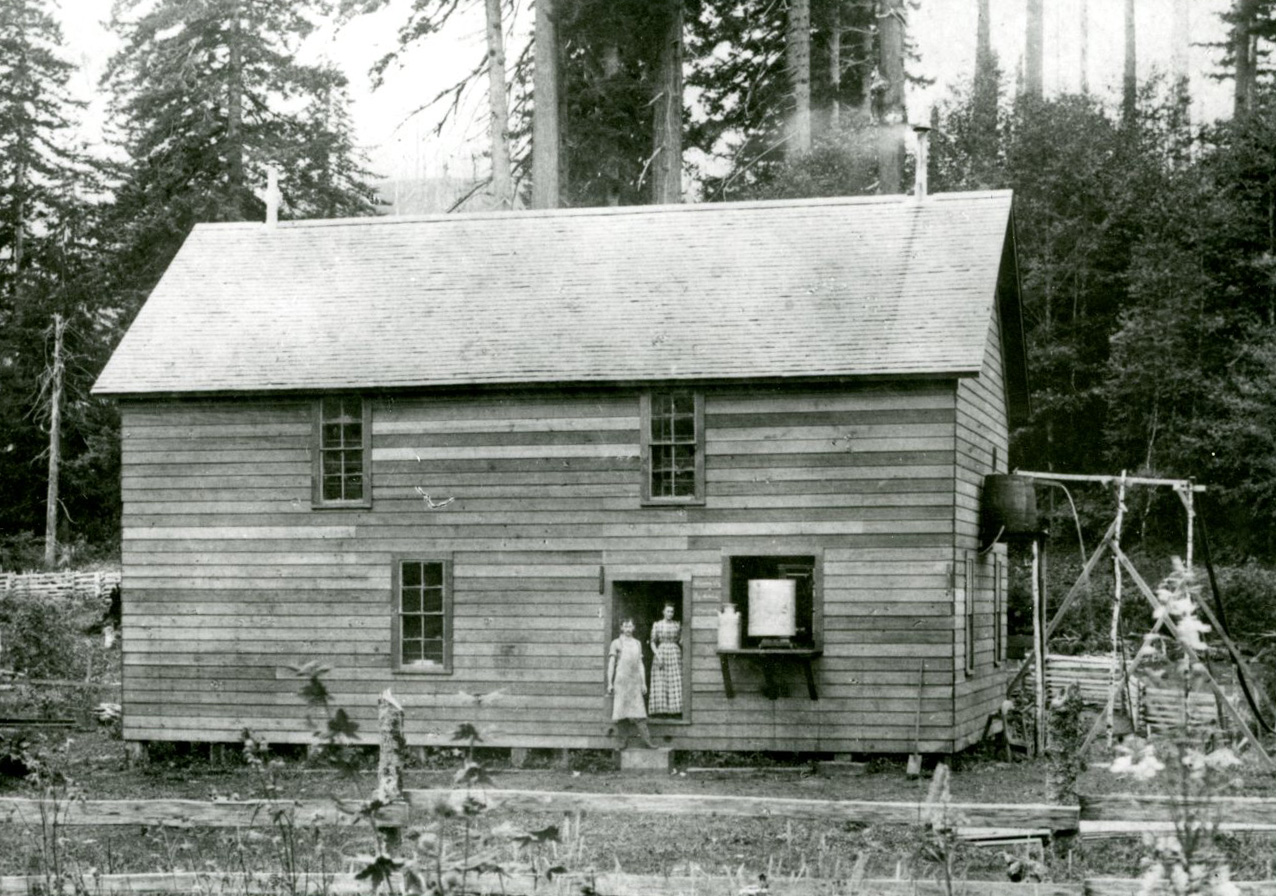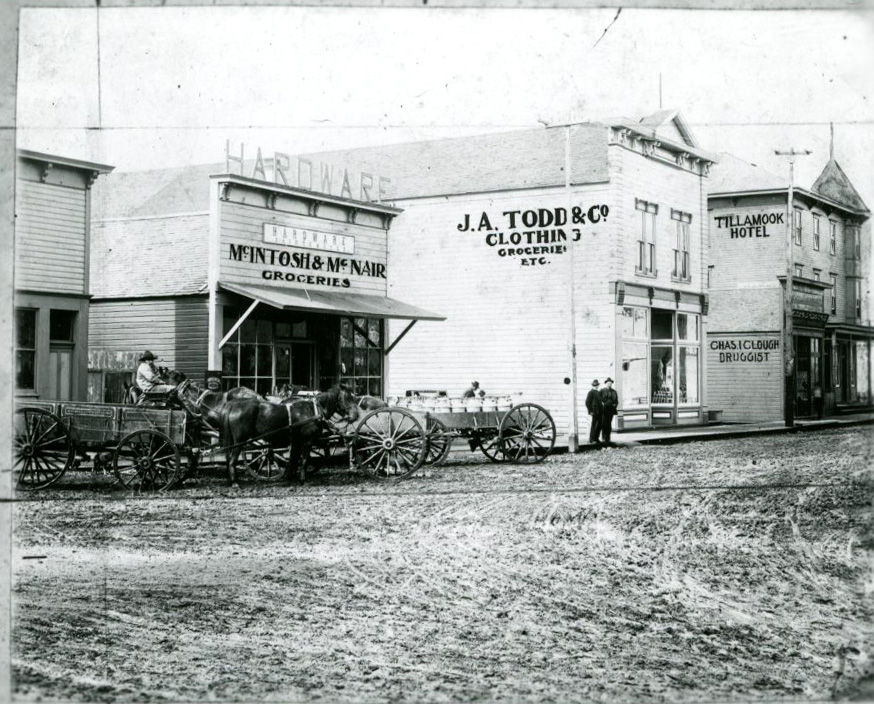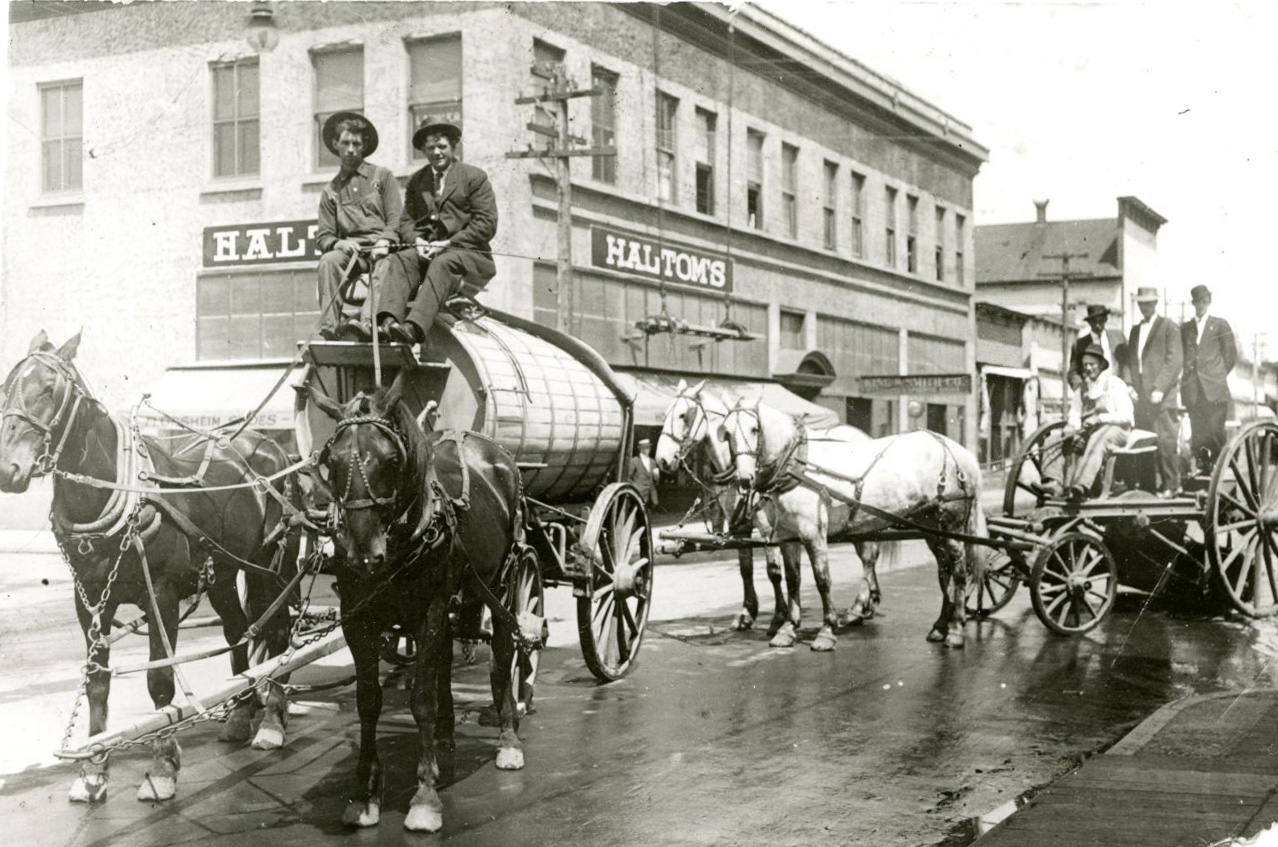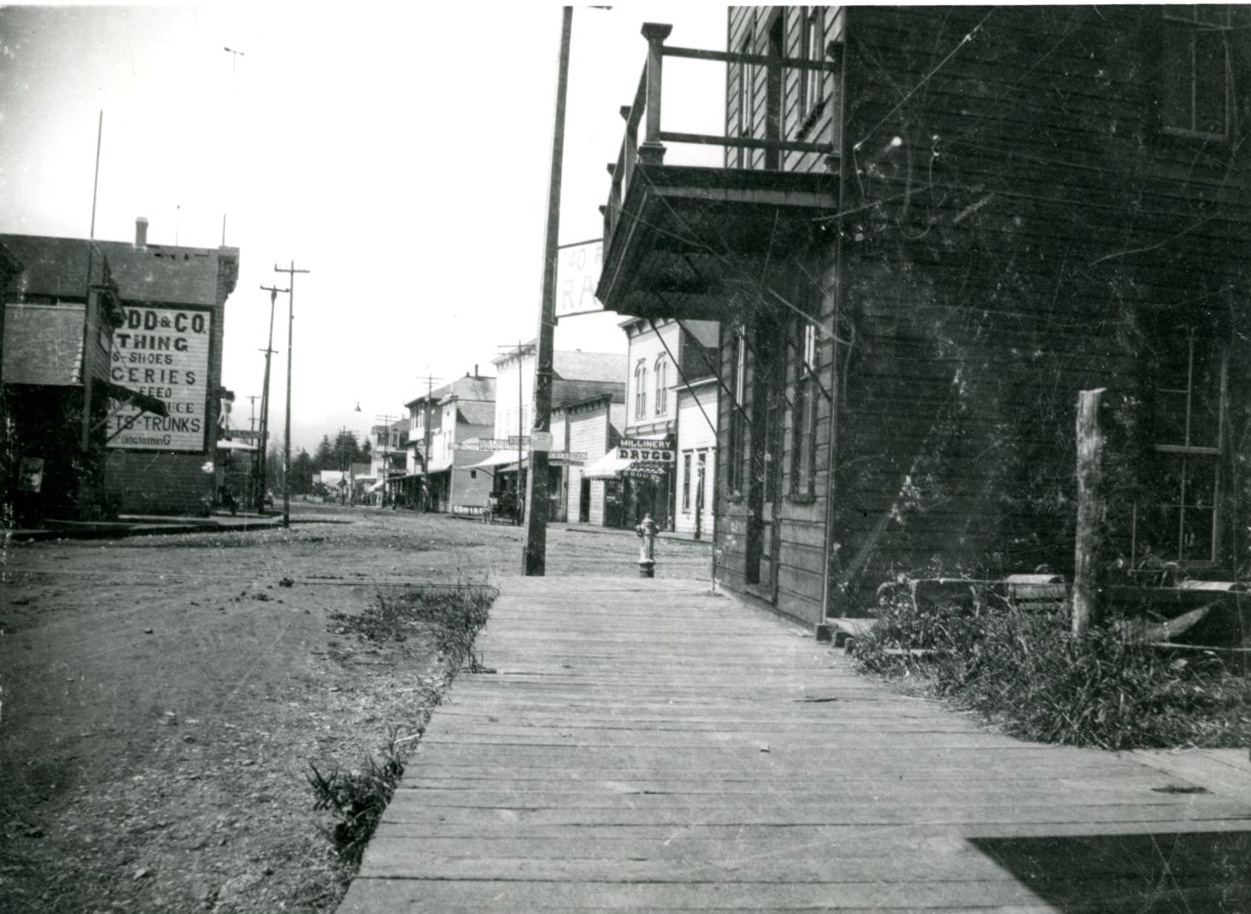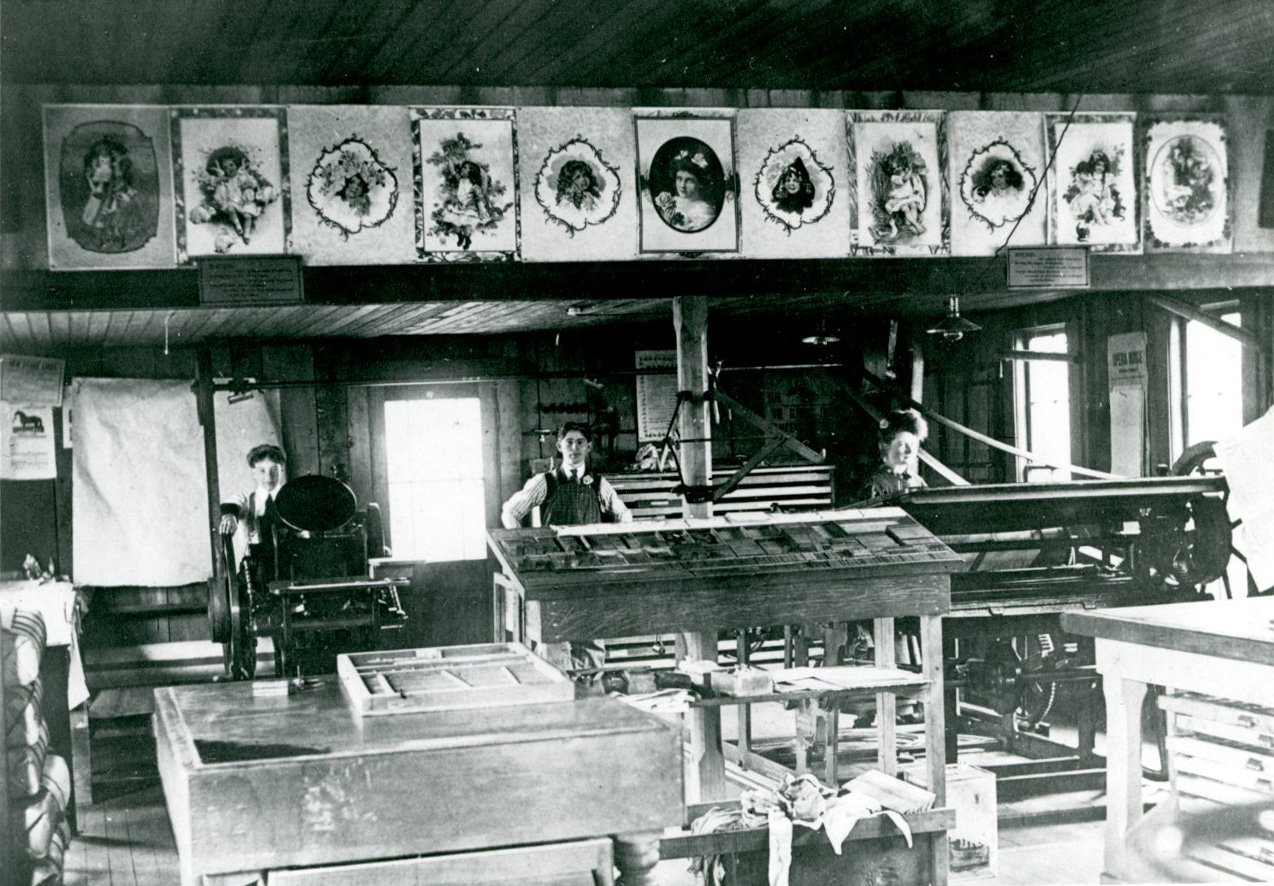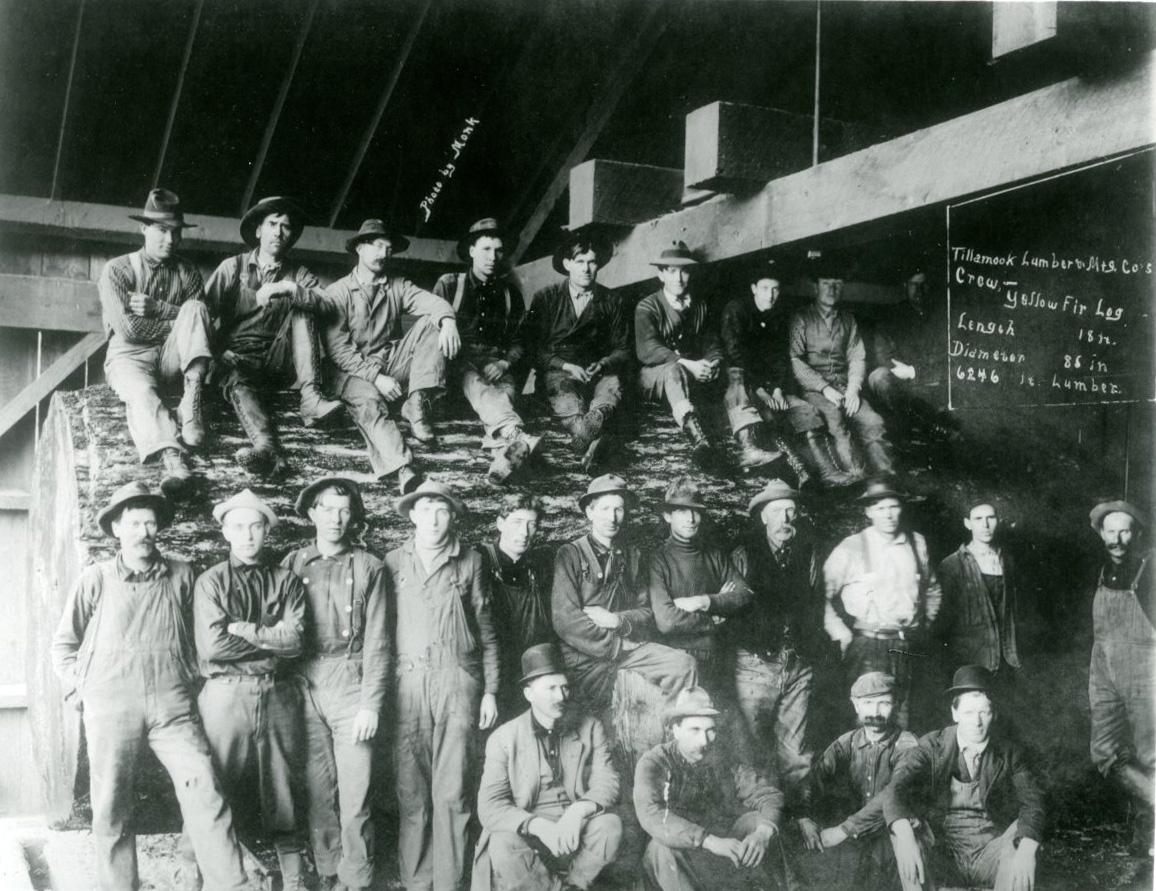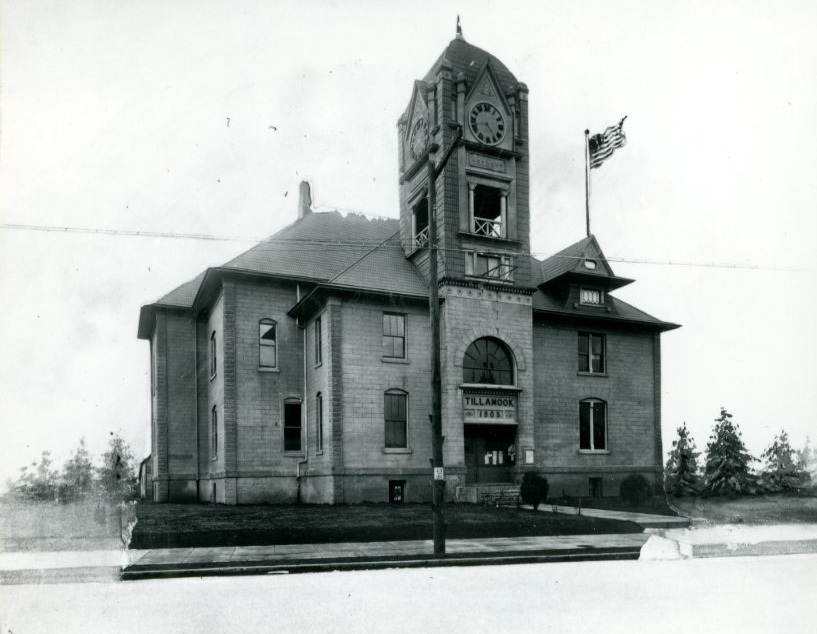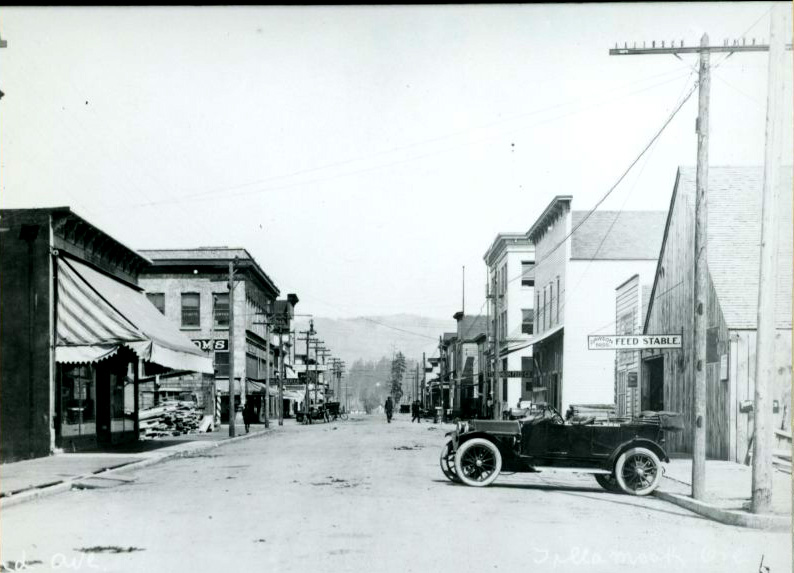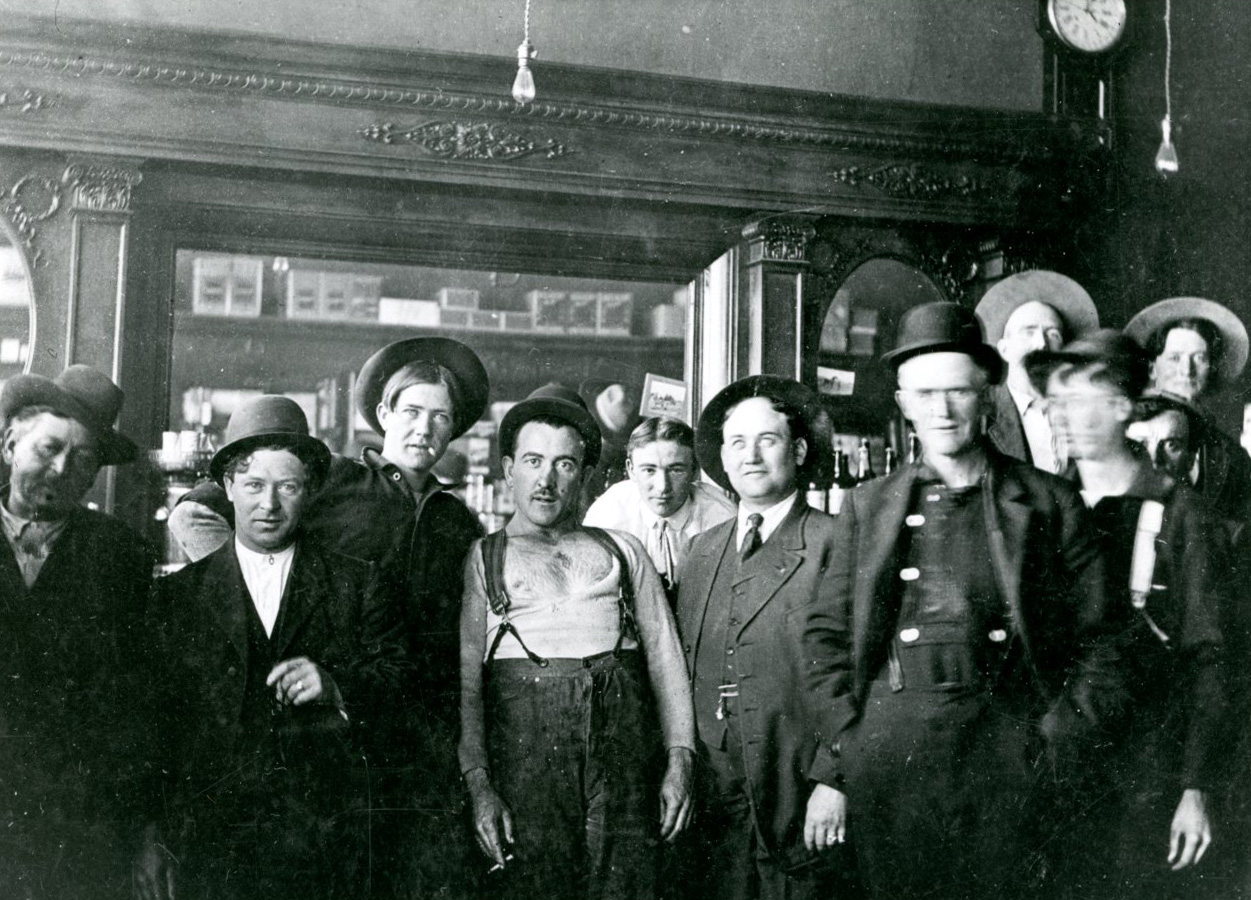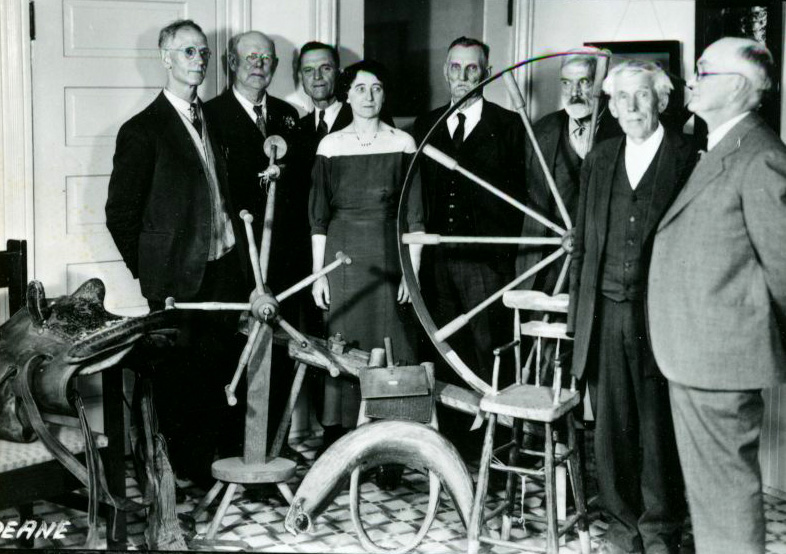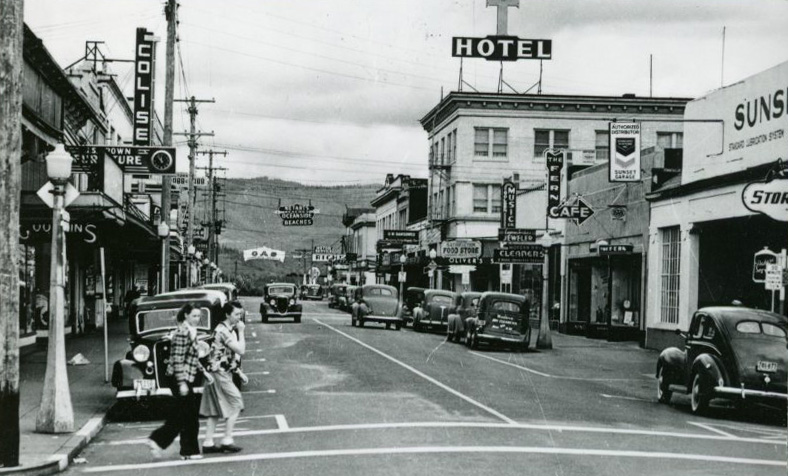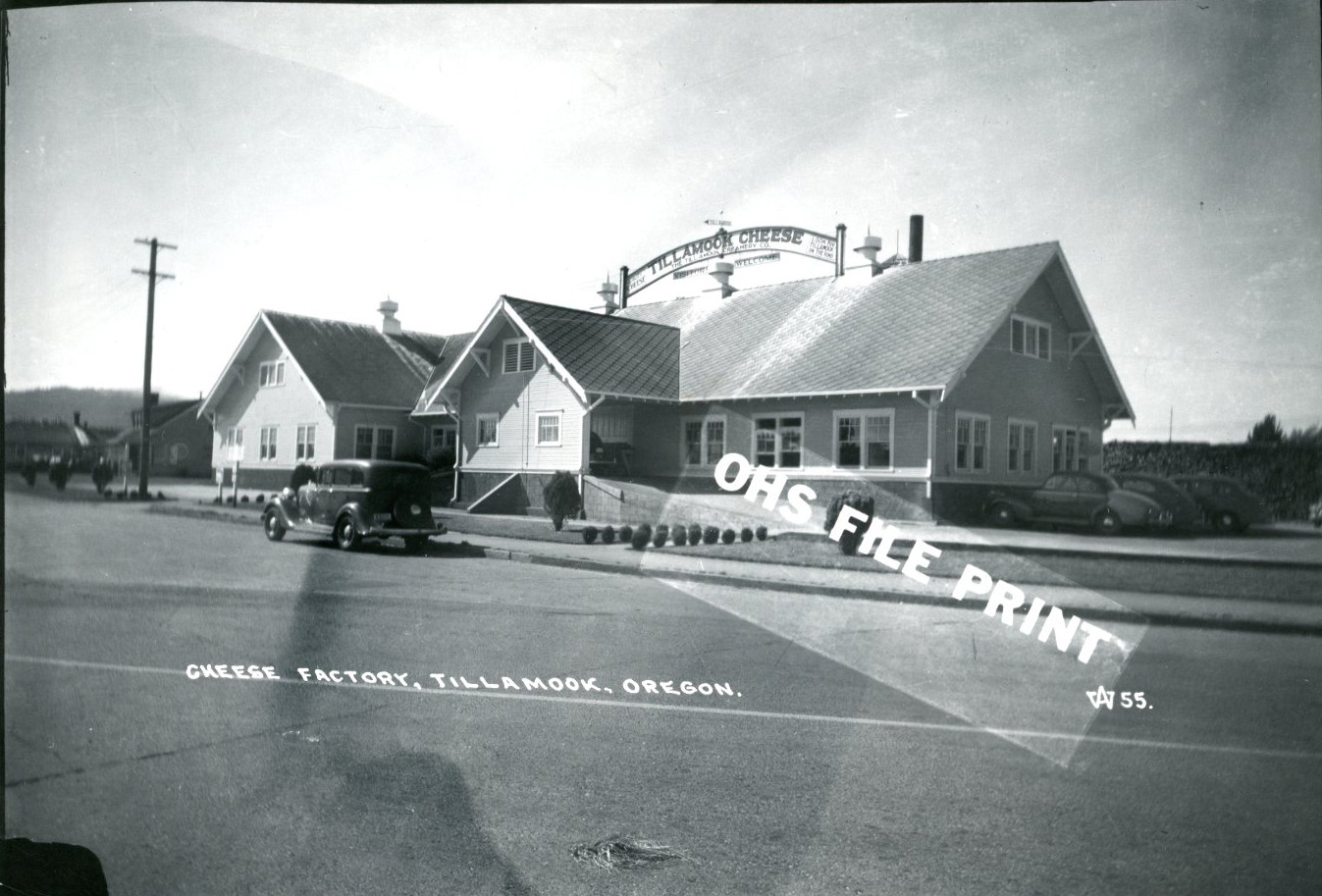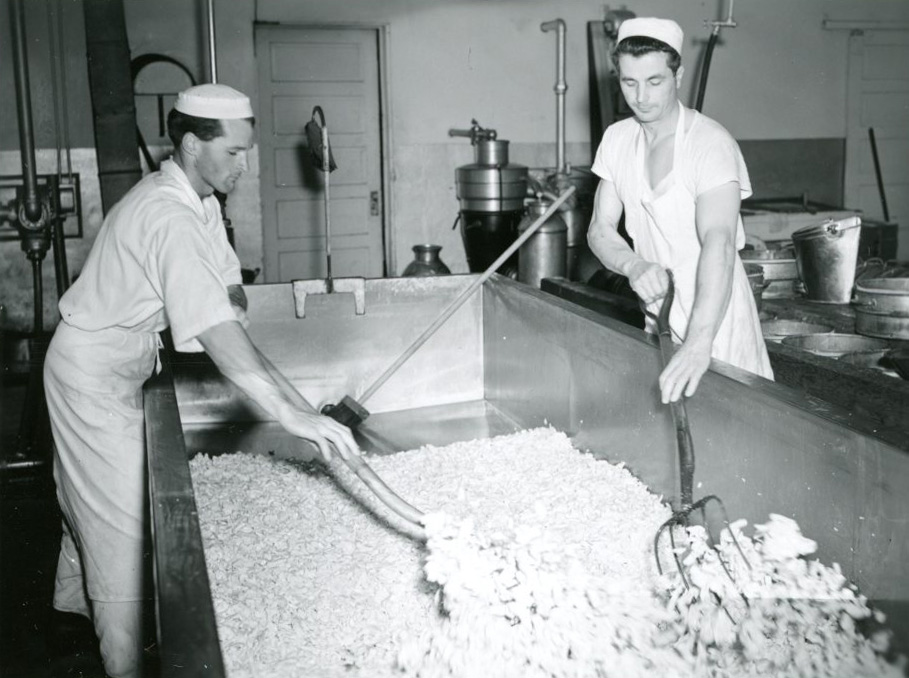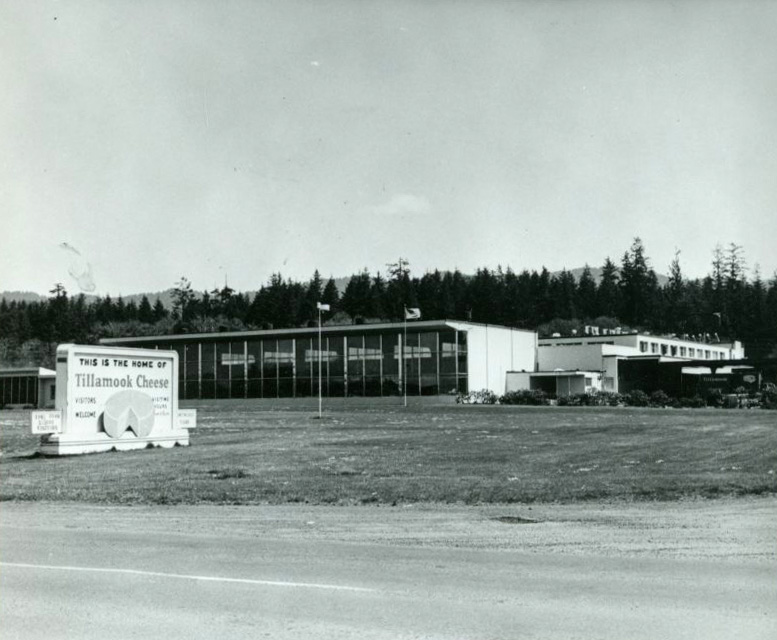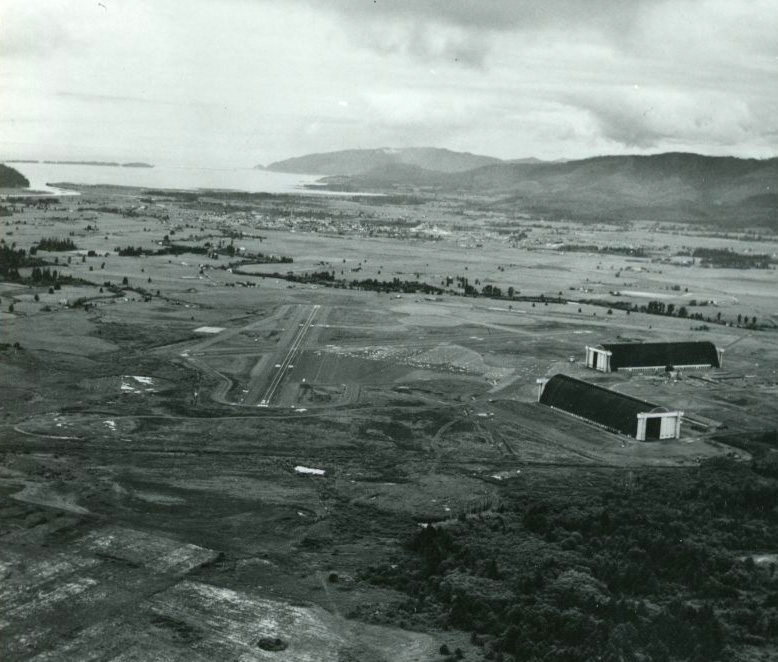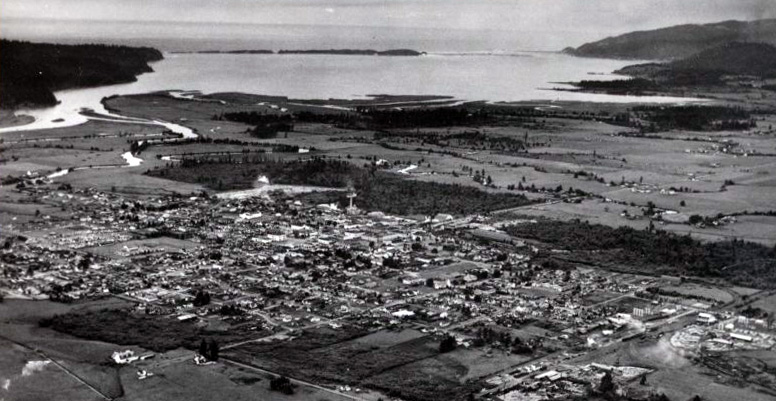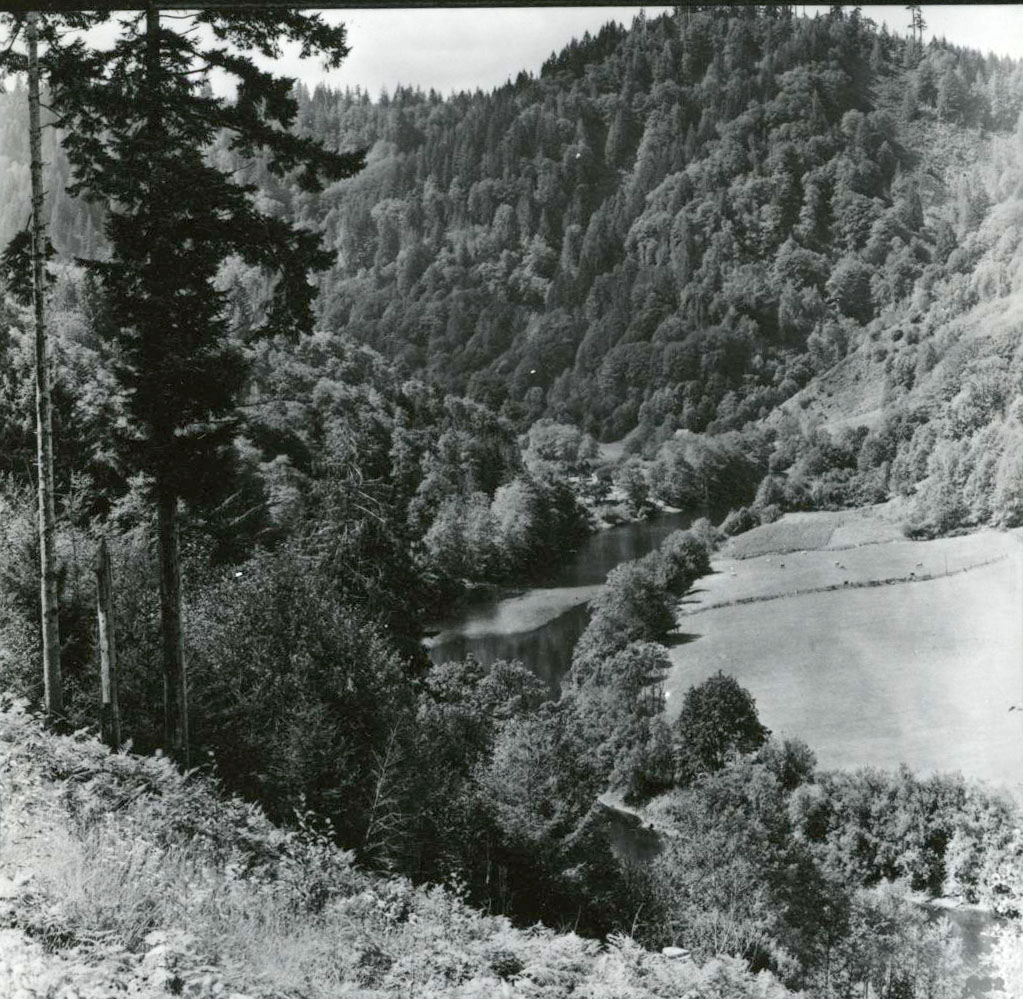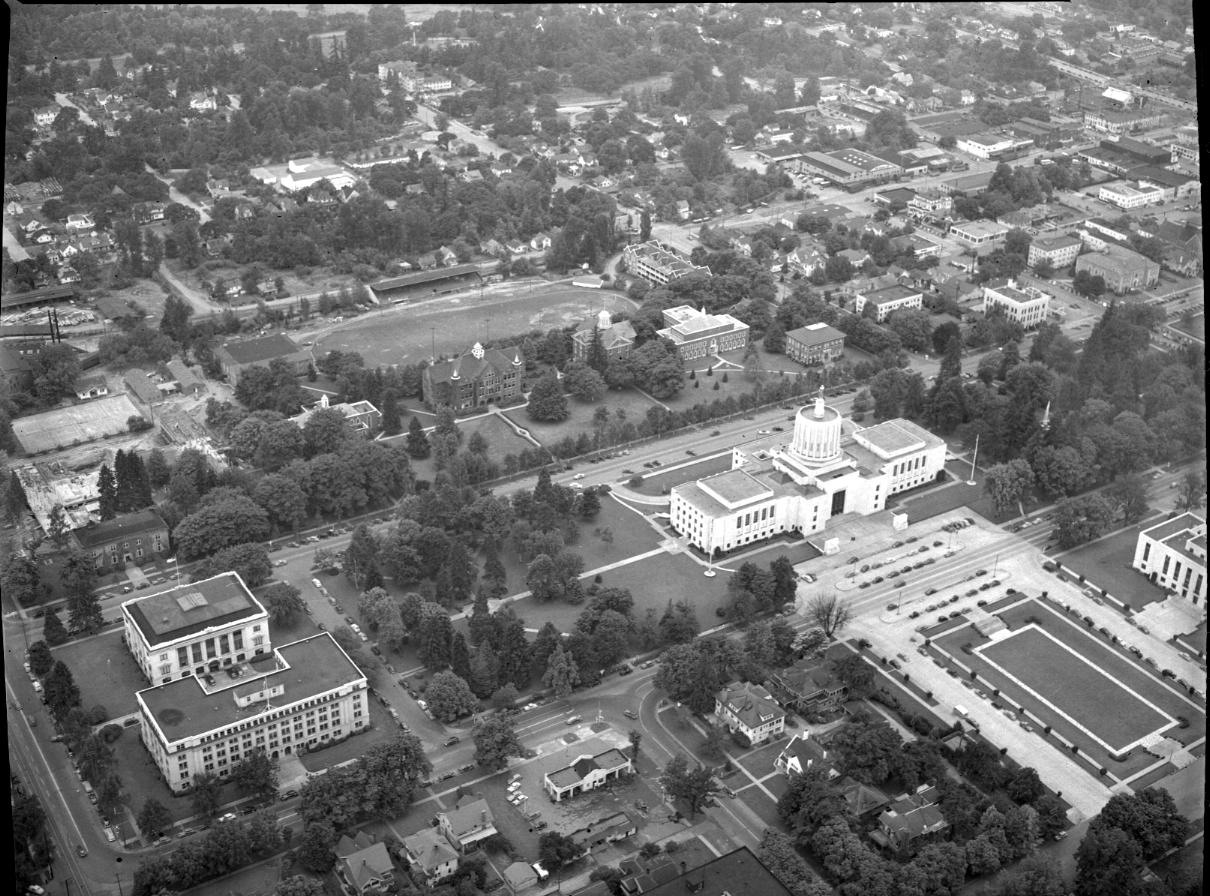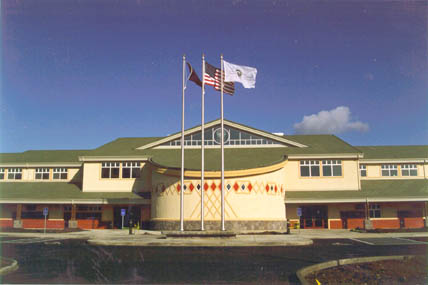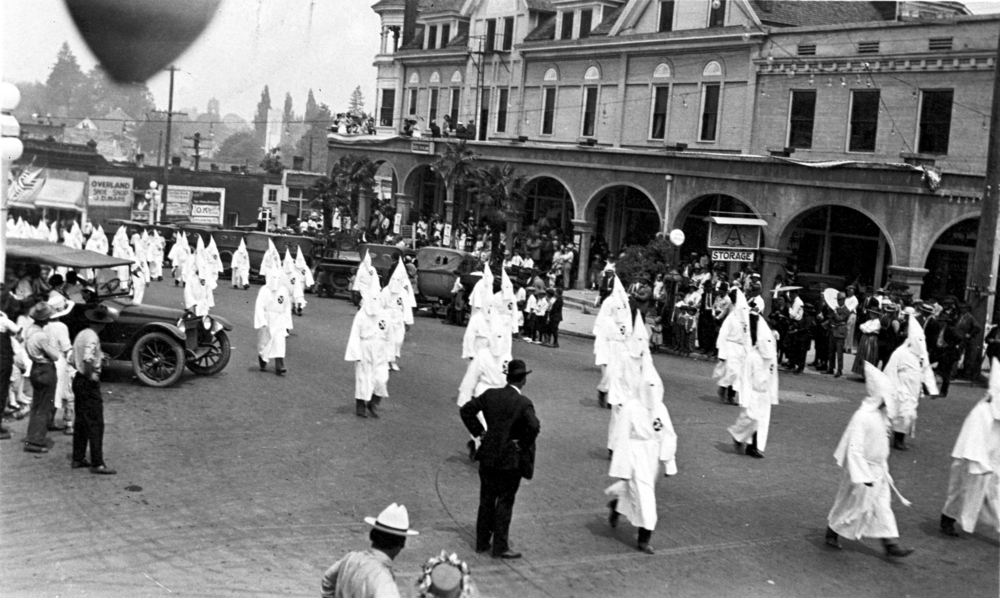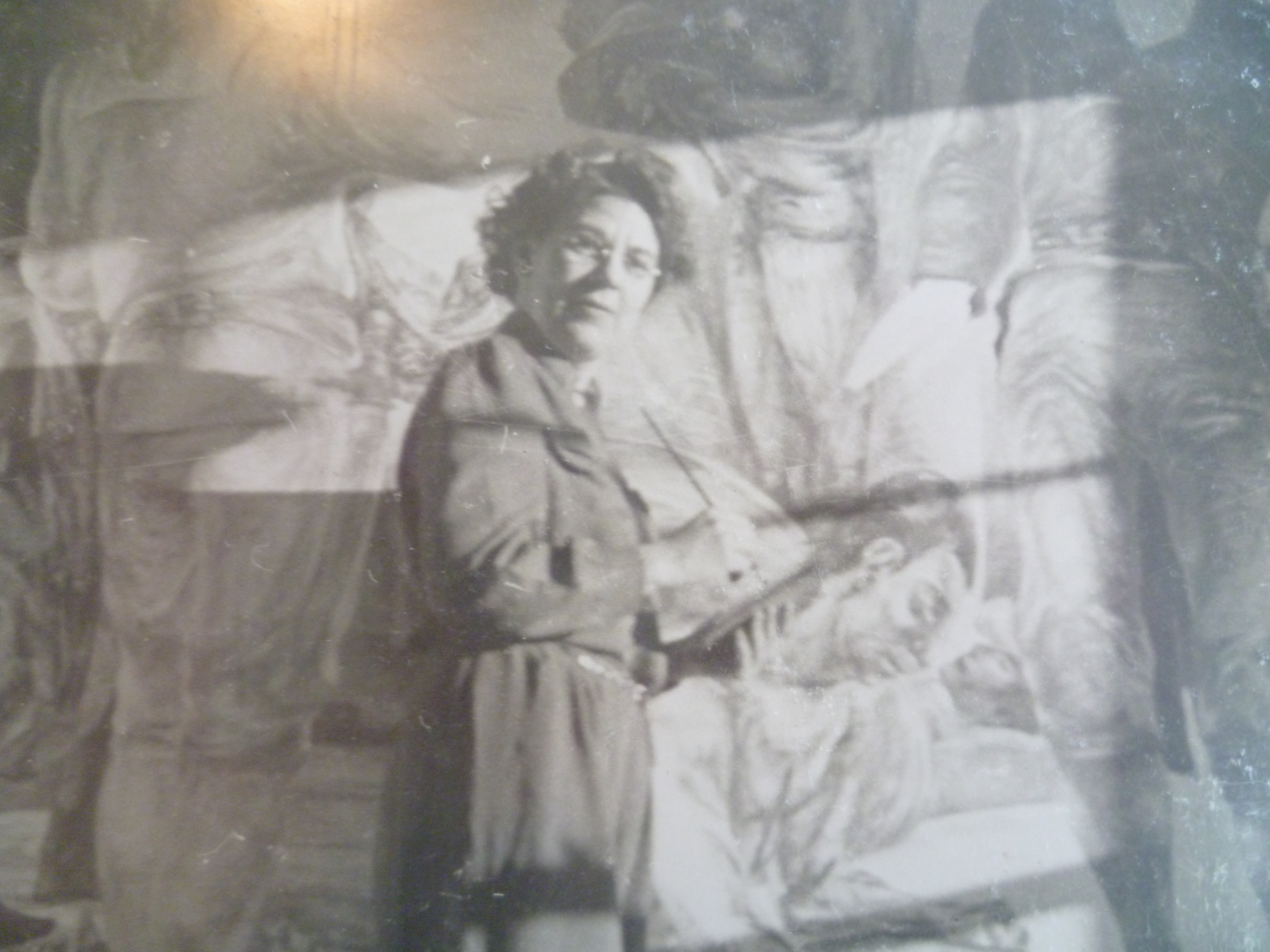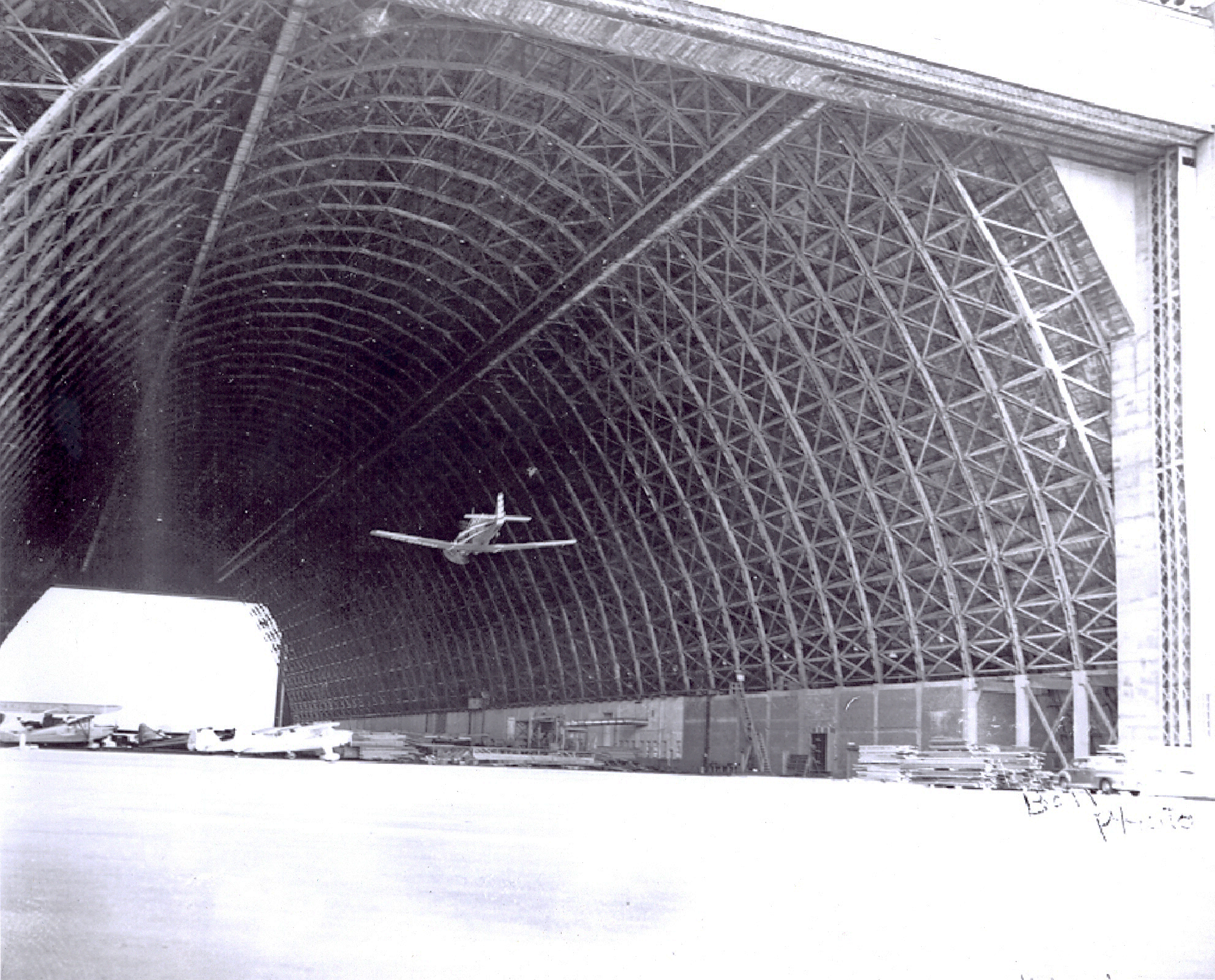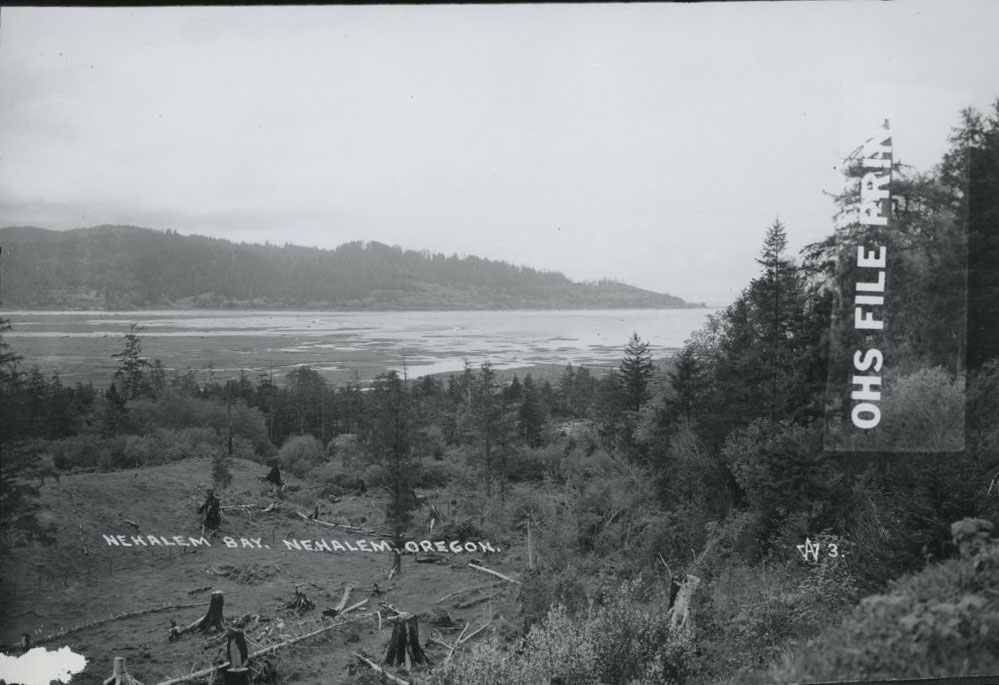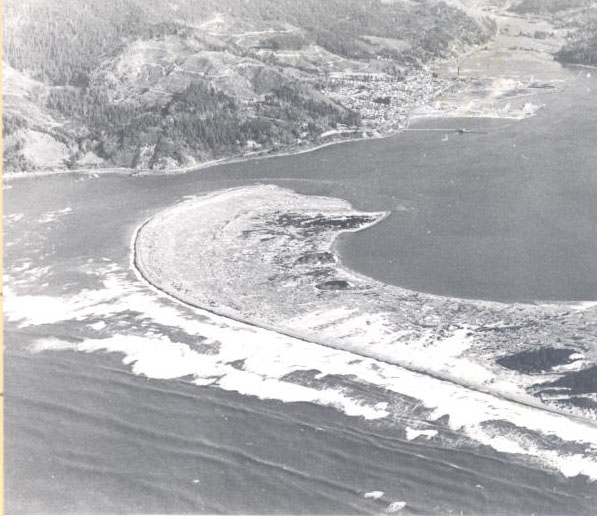Tillamook, the county seat of Tillamook County and its largest city, is located near the southeast end of Tillamook Bay, seventy-three miles west of Portland. The growth of Tillamook illustrates the development of the northwest corner of the state as a dairyland region during the late nineteenth and early twentieth centuries. The city logo is the head of a cow and the words "The Dairylands." The high school mascot is the Cheesemakers. When Oregonians think of Tillamook, many find it difficult not to think about cheese.
The name Tillamook is derived from a tribe of Salish-speaking Indians who lived in villages south of Tillamook Head. For twelve thousand years or more, Tillamook people lived at the tidewaters of the Nehalem, Tillamook, Netarts, and Nestucca Bays and at the mouths of the present-day Miami, Kilchis, Wilson, Trask, Tillamook, Salmon, and Siletz Rivers, where they favored sites with good visibility, drainage, fresh water, and firewood. They lived in permanent cedar-plank lodges with “a gabled roof of overlapping planks,” as described by anthropologists William Seaburg and Jay Miller. “Extra light,” they continue, “was provided by torches or by burning fishheads or whale oil.” They depended on marine and freshwater resources in the foothills of the Coast Range, including salmon, mussels, lampreys, berries, wild mustard, camas, grouse, beaver, deer, and elk.
Meriwether Lewis and William Clark estimated in their journals in early 1806 that twenty-four hundred Tillamooks lived in several villages, referring to the people as Kilamox, Killamuck, Cal-a-mex, and Callemex. Seaburg and Miller report that “epidemics of malaria and other diseases” killed many Tillamook people during the 1830s, and some Tillamooks were removed to the Grand Ronde and Siletz Reservations in the 1850s. Reportedly, only twenty-two lived in Tillamook County by 1930.
Joseph Champion, the first white settler in the area in 1851, lived in a large hollow spruce that local people showed him. The resettlers who followed the next year brought their families and dairy cows, and they and other whites who came to the area received help from Indians who served as guides and ferrymen. The first person to record the name “Tillamook” was government surveyor A.N. Armstrong in 1857. A post office was established on March 12, 1866, and the town was incorporated in 1891.
In 1855, with no road or railroad from Portland and the Willamette Valley, Tillamook entrepreneurs launched the schooner Morning Star to transport cheese and other dairy products to Astoria and Portland. A stagecoach road across the Coast Range was completed in 1892, and the Pacific Railway & Navigation Company line reached Tillamook from Portland in 1911. Highway 6, begun in 1936 as a Works Progress Administration project, was finished in 1941.
Fishing and lumber were important industries, and by 1899 there were as many as three lumber mills in Tillamook. The soil and climate were suited for grazing almost year-round, yielding up to five cuttings of hay in the rich bottomlands. But it was dairying that became the region’s economic staple. Merriman Foland is credited with making the first commercial cheese in Tillamook, in 1889, and Thaddeus Townsend established the first cheese factory in 1894. Ten years later, his cheese won the first national prize at the St. Louis World’s Fair. The Tillamook County Creamery Association, formed in 1909, eventually included 27 companies and 110 farmer families, and in 2010 it received the World's Best Medium Cheddar Cheese prize in Madison, Wisconsin. By 2016, Tillamook was the second largest marketer of natural cheddar cheese in the nation, after Kraft.
Members of a Ku Klux Klan klavern organized in Tillamook in the early 1920s. For ten years, from 1922 to 1932, historian Eckard Toy wrote, “the majority of municipal, county, and state officials from Tillamook were Klansmen or former Klansmen.” Local organizations such as the Masonic Lodge, the Odd Fellows, the Royal Order of the Elks, and the American Legion were fertile ground for recruitment and infiltration. The editor of the Tillamook Headlight, an avowed Klansman, bragged in his newspaper that the town was homogenously white. On May 3, 1924, the Klan held a rally in Tillamook, attended by thousands of people who watched a parade ten blocks long. The parade ended with the burning of a large cross at the fairgrounds and initiation of new members.
Intolerance surfaced again in 1992 when an antisemitic slur was spray-painted on the high school incinerator. Teacher Julianne Johnson arranged to bring the Anne Frank Exhibit to Tillamook two years later, and the Board of Commissioners declared March 27–April 10, 1994, as Anne Frank Remembrance Weeks.
The population of Tillamook has held steady since 1960, at around five thousand people, and the city serves a large rural area as the Gateway to the Oregon Coast. Anchor businesses have been the Tillamook Cheese Factory, the Blue Heron French Cheese Company, Rosenberg Builders Supply, the Farmers’ Co-op, Fred Meyer, Pelican Brewing Co., and the Tillamook Bay Community College. Attractions include kayaking, the Cape Meares Lighthouse, the Tillamook Forest Center, the Air Museum, and the Cheese Factory. The County Pioneer Museum, located in the restored 1905 county courthouse, houses Senator Mark O. Hatfield's collection of Lincoln memorabilia. Dean Runyon Associates reports that tourism brought in $72.3 million in 2016.
The Shakespeare Club, organized in 1904 and the oldest continuing social club in town, can take credit for starting the Tillamook Library in 1907. Prominent citizens include H. Clay Myers, Jr., an Oregon secretary of state and state treasurer; Robert Y. Thornton, a state attorney general and Oregon Court of Appeals judge; Lars Larson, a radio talk show host; and Lucia Wiley, a fresco artist and muralist.
-
![]()
Tillamook, Oregon, 1907.
Courtesy Oregon Hist. Soc. Research Lib., photo file 1049a
-
![]()
Street carnival, Tillamook, August 1906.
Courtesy Oregon Hist. Soc. Research Lib., 24448
-
![]()
An early birds-eye view of Tillamook, Oregon.
Courtesy Oregon Hist. Soc. Research Lib., 47326
-
![]()
Early Tillamook.
Courtesy Oregon Hist. Soc. Research Lib., 47233
-
![]()
Residents gather in early Tillamook, Oregon.
Courtesy Oregon Hist. Soc. Research Lib., 47165
-
![The Morning Star II, built in 1959.]()
Morning Star II.
The Morning Star II, built in 1959. Courtesy Oregon Hist. Soc. Research Lib., 13294
-
![]()
-
![(Early version of Chamber of Commerce)]()
First Board of Trade, Tillamook, 1891.
(Early version of Chamber of Commerce) Courtesy Oregon Hist. Soc. Research Lib., 25431
-
![Ike Hines and Elizabeth Foland operated the first cheese cooperative in the county.]()
Beaver Cheese Factory, 1893, Tillamook County.
Ike Hines and Elizabeth Foland operated the first cheese cooperative in the county. Courtesy Oregon Hist. Soc. Research Lib., 38421
-
![]()
Downtown Tillamook, 1899.
Courtesy Oregon Hist. Soc. Research Lib., 47338
-
![]()
Street cleaners in downtown Tillamook.
Courtesy Oregon Hist. Soc. Research Lib., 25574
-
![]()
Tillamook, now 1st Street, c.1906.
Courtesy Oregon Hist. Soc. Research Lib., 049173
-
![]()
Tillamook Herald newspaper office, 1907.
Courtesy Oregon Hist. Soc. Research Lib., 25756
-
![]()
Tillamook lumber crew, c.1907.
Courtesy Oregon Hist. Soc. Research Lib., 049164
-
![]()
Tillamook County Courthouse, c.1910.
Courtesy Oregon Hist. Soc. Research Lib., 015570
-
![]()
First Street, Tillamook, c.1915.
Courtesy Oregon Hist. Soc. Research Lib., 003724
-
![]()
Tillamook, 2nd Ave., c.1920.
Courtesy Oregon Hist. Soc. Research Lib., 005456
-
![]()
Tillamook saloon.
Courtesy Oregon Hist. Soc. Research Lib., 25205
-
![]()
Officers of the Tillamook Pioneer Association, 1936.
Courtesy Oregon Hist. Soc. Research Lib., 014974
-
![]()
Main St., Tillamook, 1939.
Courtesy Oregon Hist. Soc. Research Lib., 005589
-
![]()
Tillamook Cheese Factory, former building.
Courtesy Oregon Hist. Soc. Research Lib., 18452
-
![]()
Tillamook Cheese Factory.
Courtesy Oregon Hist. Soc. Research Lib., 26279
-
![]()
Offices and factory, Tillamook County Creamery Assoc., Hwy 101, 1963.
Courtesy Oregon Hist. Soc. Research Lib., 005796
-
![]()
Tillamook Air Station, 1948.
Courtesy Oregon Hist. Soc. Research Lib., 005798
-
![]()
Aerial view of Tillamook and Tillamook Bay, 1947.
Courtesy Oregon Hist. Soc. Research Lib., 005823
Related Entries
-
![Alsea Subagency of Siletz Reservation]()
Alsea Subagency of Siletz Reservation
In September 1856, Joel Palmer, the Superintendent of Indian Affairs fo…
-
![Clay Myers Jr. (1927–2004)]()
Clay Myers Jr. (1927–2004)
Clay Myers served as Oregon Secretary of State from 1967 to 1977 and as…
-
![Confederated Tribes of Grand Ronde]()
Confederated Tribes of Grand Ronde
The Confederated Tribes of Grand Ronde Community of Oregon is a confede…
-
![Ku Klux Klan]()
Ku Klux Klan
Fiery crosses and marchers in Ku Klux Klan (KKK) regalia were common si…
-
![Lucia Wiley (1906-1998)]()
Lucia Wiley (1906-1998)
Lucia Wiley was a nationally known fresco artist from Tillamook who cre…
-
![Morning Star (ship)]()
Morning Star (ship)
When commercial traders refused to stop in Tillamook in the mid-ninetee…
-
![Naval Air Station Tillamook / Tillamook Air Museum]()
Naval Air Station Tillamook / Tillamook Air Museum
Tillamook is home to the largest free-standing, clear-span wooden struc…
-
![Nehalem Bay State Park]()
Nehalem Bay State Park
Nehalem Bay State Park occupies almost 900 acres on a sand spit separat…
-
![Tillamook Bay]()
Tillamook Bay
Tillamook Bay, which encompasses a 597-square-mile watershed, is the la…
-
![Tillamook Cheese]()
Tillamook Cheese
For many Oregonians, “Tillamook” and “cheese” are inextricably linked. …
-
![Tillamook Rock Lighthouse]()
Tillamook Rock Lighthouse
Tillamook Rock Lighthouse sits on a rock a mile offshore of Tillamook H…
Related Historical Records
Map This on the Oregon History WayFinder
The Oregon History Wayfinder is an interactive map that identifies significant places, people, and events in Oregon history.
Further Reading
Boge, Lila V. Cooper, ed. Tillamook History. Tillamook County Pioneer Association, 1975.
Boyd, Robert. The Coming of the Spirit of Pestilence: Introduced Infectious Diseases and Population Decline among Northwest Coast Indians, 1774-1874. Seattle: University of Washington Press, 1999.
Hill, Helen Patti. A Brief History of Fear and Intolerance in Tillamook County. Portland, OR: Inkwater Press, 2016.
Holman, Frederick V. “History of the Oregon Counties.” Oregon Historical Quarterly 11:1 (March 1910); 1-81.
Moulton, Gary, ed. The Journals of the Lewis & Clark Expedition, Vol. 6. Lincoln: University of Nebraska Press, 1990.
Orcutt, Ada M. Tillamook: Land of Many Waters. Portland, OR: Binfords & Mort, Publishers, 1951.
Oregon Travel Impacts: 1992-2016. Salem: Oregon Tourism Commission, 2017.
Sauter, John, and Bruce Johnson. Tillamook Indians of the Oregon Coast. Portland, OR: Binfords & Mort Publishers, 1974.
Seaburg, William R., and Jay Miller. "Tillamook." In Northwest Coast, edited by Wayne Suttles, Vol. 7, Handbook of North American Indians. Washington, D.C.: Smithsonian Institution, 1990, 561.
Toll, William. “Progress and Piety: The KKK and Social Change in Tillamook, Oregon.” Pacific Northwest Quarterly (April 1978): 75-85.
Toy, Eckard V. Jr. “The Ku Klux Klan in Tillamook, Oregon.” Pacific Northwest Quarterly (April 1962): 60-64.
Vaughn, Warren N. Till Broad Daylight: A History of Early Settlement of Oregon’s Tillamook County. Wallowa, OR: Bear Creek Press, 2004.

